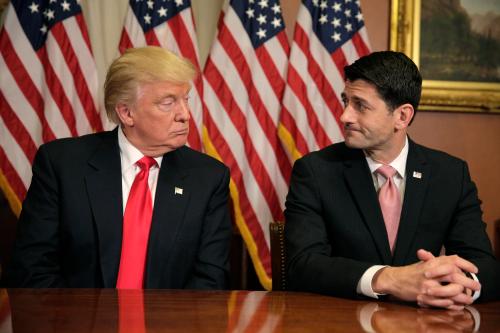Donald Trump’s first term represents an extraordinary development in what political scientists have called the administrative or unilateral presidency: how presidents seek to transform domestic policy through executive initiatives without congressional approval. Aggressive, partisan, multifaceted administrative presidencies have been especially evident since Reagan with presidents of both parties participating. Trump has in multiple ways taken this trend to new levels as his efforts to sabotage the Affordable Care Act (ACA, or Obamacare) vividly illustrate.
For analytic purposes, the term “sabotage,” should not be used lightly. Presidents upon taking office typically have priorities that trigger executive actions strengthening some programs while weakening others. The losing programs often face resource reductions, pressure to deemphasize certain goals, directives to alter their administrative approaches, and other measures that can undermine their effectiveness. In doing so, a president often pays lip service to the program, claiming it has been “modernized” or otherwise improved. In contrast, Webster’s defines “sabotage” as efforts to foster “destruction and obstruction” and to “cause the failure of something.” In the context of the administrative presidency, it reflects a commitment to program emasculation and termination through executive action. As such, it sharply departs from the constitutional requirement that the president “take care that the laws be faithfully executed.”
The Trump administration’s efforts to sabotage the ACA and their consequences receive detailed attention in a recently released Brookings book, Trump, the Administrative Presidency, and Federalism. For present purposes, I highlight six major sabotage initiatives which emerged in the wake of congressional failure to repeal and replace the ACA.
1. Reduce outreach and opportunities for enrollment in the ACA’s insurance exchanges. Established to offer health insurance to individuals and small business, the exchanges have provided coverage to some 10 million people annually. The Obama administration had vigorously promoted the ACA in part to attract healthy, younger people to the exchanges to help keep premiums down. The Trump administration sharply reduced support for advertising and exchange navigators while reducing the annual enrollment period to about half the number of days.
2. Cut ACA subsidies to insurance companies offering coverage on the exchanges. ACA proponents saw insurance company participation on the exchanges as central to fostering enrollee choice and to fueling competition that would lower premiums. The law therefore provided various subsidies to insurance companies to reduce their risks of losing money if they participated on the exchanges. The Trump administration joined congressional Republicans in reneging on these financial commitments.
3. Construct off-ramps to cheaper, lower-quality insurance. The ACA had sought to bolster the quality of health insurance through such measures as requiring insurers in the individual and small-group markets to cover ten essential benefits, guaranteeing coverage of those with preexisting conditions at premium rates similar to heathier enrollees, and reducing risks of medical bankruptcy by prohibiting insurers from imposing certain spending caps on health care for an enrollee. By promulgating new federal rules related to short-term and also employer association health plans, the Trump administration strove to expand access to cheaper coverage that did not meet these quality standards and would siphon off healthier enrollees from the exchanges.
4. Promote waivers that would decrease ACA enrollments and undermine its regulatory structure. The Trump administration approved demonstration waivers from several states that imposed work requirements and administrative burdens on non-elderly adults benefitting from the ACA’s Medicaid expansion. CMS also invited states to use new ACA waiver authority to propose alternatives that departed sharply from the “guardrails” that the Obama administration had established to assure that these waivers did not water down coverage.
5. Discourage legal “aliens” from enrolling in Medicaid. The Department of Homeland Security promulgated a “public charge” rule that authorized officials to treat Medicaid enrollment as a negative factor in reviewing the requests of legal noncitizens to extend their stays or change their status (e.g., from temporary to permanent resident).
These five sabotage initiatives precipitated some erosion in ACA enrollments and benefits; they probably contributed to a slight uptick in the number of uninsured Americans. On balance, however, the ACA proved resilient. Roughly 20 million individuals remain enrolled in the exchanges and via the Medicaid expansion. The number of states opting to expand Medicaid during Trump’s first term grew from 31 to 38 (plus the District of Columbia). People with preexisting conditions continue to benefit from the ACA’s quality regulations.
ACA resilience largely reflects the potency of state attorneys general, other state policymakers, and private parties in resisting sabotage. Insurance companies have successfully sued to thwart Republican efforts to eradicate their subsidies. Even before that, they obtained approval from most state insurance commissioners to do “silver loading”—an arcane premium strategy that allowed them to replace the revenues lost from federal cuts. In turn, Democratic state attorneys general have used the courts to block certain Trump initiatives to promote lower-quality insurance, and to slow down his public charge initiative. For their part, private advocacy groups have successfully sued to derail work requirement waivers. Moreover, if Biden wins the election, he could reverse most of the Trump administration’s sabotage initiatives.
The modest accomplishments of Trump’s sabotage strategy could, however, be transformed into a resounding success through a sixth initiative: persuading the Supreme Court to destroy the ACA. In recent decades, the decision on whether to have the Justice Department defend a law’s constitutionality has become a prominent tool of the administrative presidency. So it is with the most recent legal challenge to the ACA that the Supreme Court will hear just after the election. The case arose from a suit filed by 18 Republican state attorneys general, two Republican governors, and two Texas residents in a federal district court. The suit reasoned that, since Congress in 2017 had eliminated the financial penalty for failure to obtain health insurance, the mandate to purchase coverage that remained in the law was unconstitutional and invalidated the entire ACA. Judge Reed O’Connor, a George W. Bush appointee, concurred with this view. O’Connor’s decision was an epiphany for the White House. The Justice Department had originally argued that the remaining, toothless mandate invalidated only a portion of the ACA, primarily protections for those with preexisting conditions. Now, and against the advice of his attorney general, the president embraced overturning all of the ACA’s core provisions.
Legal scholars and pundits from across the ideological spectrum have panned Judge O’Connor’s ruling. But it poses a genuine threat to the ACA. Two Republican-appointed judges on the Fifth Circuit Court of Appeals (with a Democratic appointee dissenting) upheld the core of O’Connor’s ruling while remanding the case back to him to consider whether portions of the law could be salvaged. Meanwhile, Democratic state attorneys general persuaded the Supreme Court to hear the case. The passing of Justice Ginsburg and President Trump’s nomination of circuit court judge, Amy Coney Barrett, to replace her heighten the existential threat to the ACA. Barrett has been sharply critical of earlier Supreme Court decisions sustaining the law’s constitutionality.
Current developments illuminate how the administrative presidency can exploit its control over the Justice Department to coalesce with state officials of the same party to accomplish its policy goals. They also have relevance for the ongoing debate among political scientists as to whether federal judges are best seen as partisans in robes, whose voting behavior on salient policy matters reflects those of the party of the president who appointed them. To this point, recent court decisions on the individual mandate have faithfully followed the partisans-in-robes model. It remains to be seen whether the pending Supreme Court decision mirrors that pattern.








Commentary
Six ways Trump has sabotaged the Affordable Care Act
October 9, 2020